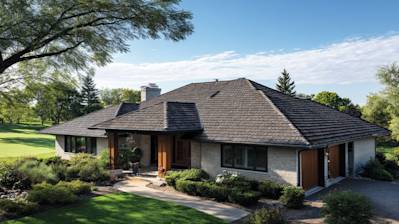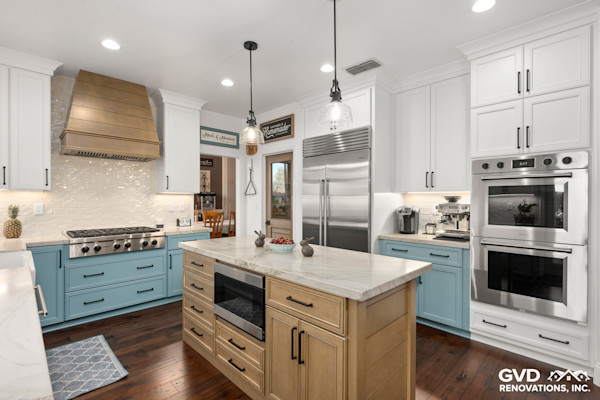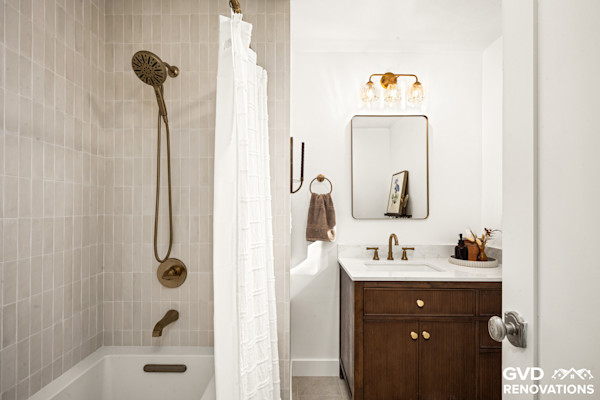Roofing is a critical aspect of home improvement, topping off your beloved house by offering stability, insulation, and protection from harsh weather conditions. In the quest for durable and energy-efficient roofing solutions, many homeowners have turned to metal roofs. This comprehensive guide will outline how to install a premier Sacramento metal roof - a seemingly challenging task made simpler.
What is Metal Roofing?
Metal roofing is an eco-friendly, sturdy roofing solution available in different materials, styles, and colours. Examples of materials include steel, aluminum, copper, and zinc alloy. Each material offers unique benefits, but all share the common traits of durability and energy efficiency.
Basic Tools and Materials Needed
Before delving into the steps, let's prepare the required tools and materials.
- High-quality metal roof panels
- Roof underlayment
- Galvanized metal roof screws
- Metal roofing caulk sealant
- Circular saw with metal cutting blade
- Screw gun
- Tape measure
- Chalk line
- Ladder
- Safety glasses and gloves
Pre-installation Preparations
The initial stages of installing a metal roof involve cleaning the workspace and taking cautionary safety measures.
Clean the Workspace
Ensure the area around your house is clear for easy access to ladders and tools. Cover your garden or any delicate outdoor ornaments to protect them from falling debris.
Take Safety Precautions
Wear safety glasses and sturdy gloves. Put on a harness, especially if the roof is high off the ground. Keep all cords and ladders away from wet areas to prevent accidental electrocution.
Metal Roof Installation Steps
After securing safety measures and preparatory stages, it's time for the actual installation of the metal roof. Here's your step-by-step guide:
Step 1: Measure The Roof
Use a tape measure to calculate the length and breadth of your roof, accounting for overhangs. Ensure accurate measurements as they determine the number of metal roofing panels required.
Step 2: Install Roof Underlayment
Lay the underlayment from the bottom of the roof to the top, securing it with cap nails. It protects the metal roof from any residual moisture and offers additional insulation.
Step 3: Cut and Install Metal Panels
Following your roof measurements, cut your metal panels using a circular saw with a metal cutting blade. Start installing from the bottom up, aligning the first panel with the edge of the roof. Screw it in at the pre-drilled holes. Keep adding panels, making sure they overlap correctly for a firm installation.
Step 4: Install Flashing
Considered the final part of the installation, flashing adds extra leak protection. Install flashing at key points like the ridge of the roof or any areas intersecting a wall.
Step 5: Apply Caulk Sealant
Apply sealant around the screws and on the flashing for added reinforcement and to prevent leaks.

Frequently Asked Questions about How To Install A Metal Roof
What Are the Primary Steps in Installing a Metal Roof?
While the exact steps can vary depending on the specific type of metal roofing material you plan to install, the basic steps usually include: removing old roofing (if necessary), applying roofing underlayment, installing metal edging around the perimeter of the roof, laying out the metal panels or shingles, fastening the panels or shingles in place, installing the trim, and sealing the roof.
Is Any Special Equipment Needed to Install a Metal Roof?
You may require specific equipment to safely and efficiently install a metal roof. Essential tools and materials include safety gear (like a harness), power tools for cutting and fastening the metal sheets, measuring tools, and potentially a crane for lifting heavier materials. Also, it’s important to remember the need for screws specifically designed to fasten metal roofing, as regular nails are not suitable.
How Long Does It Take to Install a Metal Roof?
The time it takes to install a metal roof greatly depends on the size of the roof, the type of metal roofing being installed, and the expertise of the installer. An average-sized home might take a professional crew of four about two to four days to complete the installation, weather permitting. It might take considerably longer if you are trying to do the installation yourself.
How Much Does It Cost to Install a Metal Roof?
The cost to install a metal roof can range greatly depending on the type of metal used, the size and complexity of the roof, and local labor rates. On average, homeowners can expect to pay between $10,000 and $14,000. This includes materials, labor, and disposal of old roofing if needed. However, due to the durability of metal roofs, you can expect a return on investment in the long term.
What Types of Metal Are Used in Roofing?
Several types of metal can be used for roofing. The most common types are steel and aluminum because they are lightweight, durable, and affordable. Steel is often coated with a layer of zinc to protect it from corrosion. Other types like copper, zinc, and stainless steel are more expensive but also offer higher longevity and unique aesthetic appeal.
Do I Need to Remove My Old Roof to Install a Metal One?
Not always. One of the advantages of metal roofing is that in some cases, it can be installed over an existing roof, eliminating the need for tear-off and disposal. However, this step is dependent on local building codes and the condition of the current roof.
Can a Metal Roof Be Installed in Any Weather?
Installation in extreme weather conditions—like heavy rain, snow, or high wind—is usually not recommended as it can increase the risk of injury and compromise the quality of the installation. Therefore, milder, dry weather is considered ideal for installing a metal roof.
Can I Add a Metal Roof to a Flat Roof Home?
Yes, you can install a metal roof on a flat or low-slope roof. However, it's essential to choose the right kind of metal roofing system—like standing-seam or metal shingles—that is specifically designed for lower sloped roofs. It's always essential to consult with a roofing professional to ensure you choose the right system for your home.
How Do I Choose a Contractor to Install a Metal Roof?
When choosing a contractor to install a metal roof, look for those with extensive experience with metal roofing, positive customer reviews, and in-depth knowledge about building codes and regulations. Also, ensure they offer warranties for their work and have proper licensing and insurance.

Pros and Cons: How to Install a Metal Roof
This section dives deep into the pros and cons involved in the installation of a metal roof. It highlights not only the benefits but also the potential drawbacks that often accompany this type of project.
Pro: Durability and Longevity
Pro: Resistance to Harsh Weather
Metal roofs are immensely strong against all types of weather conditions. They maintain their integrity against high winds, hail, and heavy rain, outperforming many other roofing materials. Consequently, homeowners who reside in areas prone to severe weather often opt for metal roofs to ensure their homes remain protected.
Pro: Life Expectancy
Metal roofs have an outstanding life expectancy. Whereas asphalt roofs have an average lifespan of 15 to 20 years, metal roofs can last upwards of 40 to 70 years. This long lifespan makes them an attractive investment for homeowners, as they reduce the need for frequent replacements.
Pro: Fire Resistance
An enormous benefit of installing a metal roof is its fire resistance. Unlike roofs made of flammable materials, metal roofs are highly resistant to fire, which provides peace of mind, particularly in fire-prone regions.
Pro: Environmental Impact
Pro: Energy Efficiency
Metal roofs are highly energy-efficient. They reflect solar heat which can reduce cooling costs by 10-25%, supporting lower energy consumption during the warmer months of the year.
Pro: Recyclability
Finally, metal roofs are 100% recyclable at the end of their long life, contributing to less waste in landfills. This is vastly different from asphalt shingle roofs that contribute millions of tons of waste annually.
Con: Installation and Costs
Con: Installation Difficulty
The installation of a metal roof is more complex compared to other roofing materials and often requires a professional contractor. It's neither a quick nor easy task. An error in installation not only risks immediate problems such as leaks but can also cause long-lasting damage, deteriorating the value of your investment.
Con: Higher Initial Cost
While metal roofs can last longer than conventional roofs and offer numerous benefits, they also come with a higher initial cost. Material and installation costs for metal roofing can be roughly two to three times more expensive compared to traditional asphalt roofs.
Con: Noise Issues
Under heavy rain or hail, a metal roof can be considerably louder than other roofing materials. While some people enjoy the sound of rain on a metal roof, others find it disturbing.
Con: Expansion and Contraction
Metal roofs are known to expand and contract. If they are not correctly installed with fasteners that allow the metal to 'breathe,' this can lead to loosening of panels, deforming their shape over time.
Con: Risk of denting
Although metal roofs are durable, they are susceptible to denting from large hailstones or falling branches. Care should be taken to prune overhanging trees.
Con: Replacement Difficulty
Should part of your metal roof need replacing, matching the color and finish of the original panels can be challenging. Over time, weathering and fade can alter the color of your roof, and new panels might not match perfectly.

Myths and Misconceptions about Metal Roofing
In today’s modern world, misconceptions and inaccurate information can proliferate easily, particularly in the roofing industry. Despite the rising popularity of metal roofing, there remain a number of myths and misconceptions which perpetuate, causing confusion and shaping negative beliefs about this valuable roofing solution. This section aims to debunk many of these misconceptions.
Myth 1: Metal Roofs Attract Lightning
Reality:
One of the most prevalent myths is that a metal roof will increase the likelihood of your home getting struck by lightning. True fact? Absolutely not. Metal conducts electricity, but it does not attract lightning or increase the chances of a lightning strike. In reality, the factors determining whether lightning will hit a given location are the height of the structure, the geographical location, and the size of the structure.
Even in an unlikely event your metal roof does get struck, it's actually safer than other roof types because it can disperse the energy safely throughout the structure.
Myth 2: Metal Roofs are Noisy
Reality:
Peoples’ perception of metal roofs often harks back to old tin-roofed barns or rain on a corrugated metal shed. However, this image is not an accurate portrayal of what a modern, properly installed residential metal roof sounds like. In fact, metal roofs with solid sheathing attached to the undersides reduce noise from rain and hail, often quieter than other types of roofs.
Myth 3: Metal Roofs are Prone to Rust
Reality:
Contrary to popular belief, modern metal roofs are built to last and resist rust. They are typically manufactured from galvanized steel or aluminum and are additionally coated with a high-performance paint that provides further protection against rust and decaying.
Myth 4: Metal Roofs don't Allow for Ventilation
Reality:
Properly installed metal roofing systems have the same types of vents as shingle roofs or any other roofing system. Ventilation is determined by the construction of the roof and not the type of roofing material used.
Myth 5: You Can’t Walk on a Metal Roof
Reality:
It's a common belief that you can’t walk on a metal roof as it will dent or get damaged. While it's true that care must be taken, just like any other roof, it's generally safe to walk on a metal roof. Professionals who are familiar with the material and have the proper knowledge and equipment can certainly walk on a metal roof without causing damage.
Myth 6: Metal Roofs are not Suitable for Harsh Climates
Reality:
Another common misconception is that metal roofing is not suitable for areas with harsh climate conditions, like heavy rainfall, hail, high winds, or snow. However, metal roofs are actually incredibly durable and resistant to these conditions. They can withstand high speed winds, are fire-resistant, shed snow and ice quicker than other roofs, which makes them even suitable for extreme weather conditions.
Myth 7: Metal Roofs have Limited Design Options
Reality:
Some people believe that metal roofs only come in a few designs and will make their home resemble a barn or commercial building. In reality, metal roofs come in numerous styles, colors, and textures. They can mimic the appearance of other roofing materials like slate, wood shakes, and tiles, while offering more durability and longevity.
If you are considering a metal roof for your home or building, don’t be swayed by outdated myths and misconceptions. Modern metal roofs have come a long way and have many benefits which make it a great choice for a variety of applications. It's best to do your own research or speak directly with a knowledgeable roofing professional to get accurate information. Remember, myths are merely myths - and they shouldn't stand between you and the decision that's right for your home.
Summary
It's easy to see that knowing how to install a metal roof can really come in handy. Not only does it save a lot of money on professional installation costs but also provides a great feeling of accomplishment. Remember, the process can seem a bit challenging at first, but with patience and practice, it gets easier. Just take it step by step - from measuring the surface, ordering material, prepping the roof, securing the underlayment to laying metal panels and fitting trim.
So there you have it! While it might seem like a huge task to tackle, learning how to Install a Metal Roof is certainly a skill worth acquiring. It's all about understanding the commands, getting hands-on with the tools, and following safety measures. With the right knowledge and gear, it's more than possible to get it done within a weekend. Just keep in mind, it's always better to double-check measurements, follow guidelines closely and never rush the process. A well-installed metal roof can last years, protecting your home and increasing its value.
Therefore, if you're a homeowner looking to switch to a more durable, sustainable roofing option, knowing how to install a metal roof can prove really beneficial. It may seem daunting at first, but once you've gathered the necessary materials and tools, it's just a matter of following the process consistently. Plus, the satisfaction of completing a DIY project is unbeatable. Hope this guide helps you on your way to installing a metal roof, and good luck with your home improvement journey.
About GVD Renovations & Remodeling
At GVD Renovations & Remodeling, we are Roseville, CA’s go-to home remodeling company. With countless years of experience, we’ve become passionate experts in a variety of services such as kitchen renovations, bathroom remodels, siding installations, window replacements, and more. Our skilled team is committed to delivering high-quality work that transforms your living space into the dream home you've always wanted. When it comes to delivering a seamless remodeling and renovation experience, there's simply no one better. So why wait? Trust GVD Renovations & Remodeling – we're just a phone call away!
This article is for general information only and not professional advice. Always consult a licensed contractor before making project decisions. Product details, specifications, or warranties may have changed since publication. Brand and product mentions reflect opinion, not endorsements or guarantees.
Tags: metal roofing, installation guide, roof installation,





















